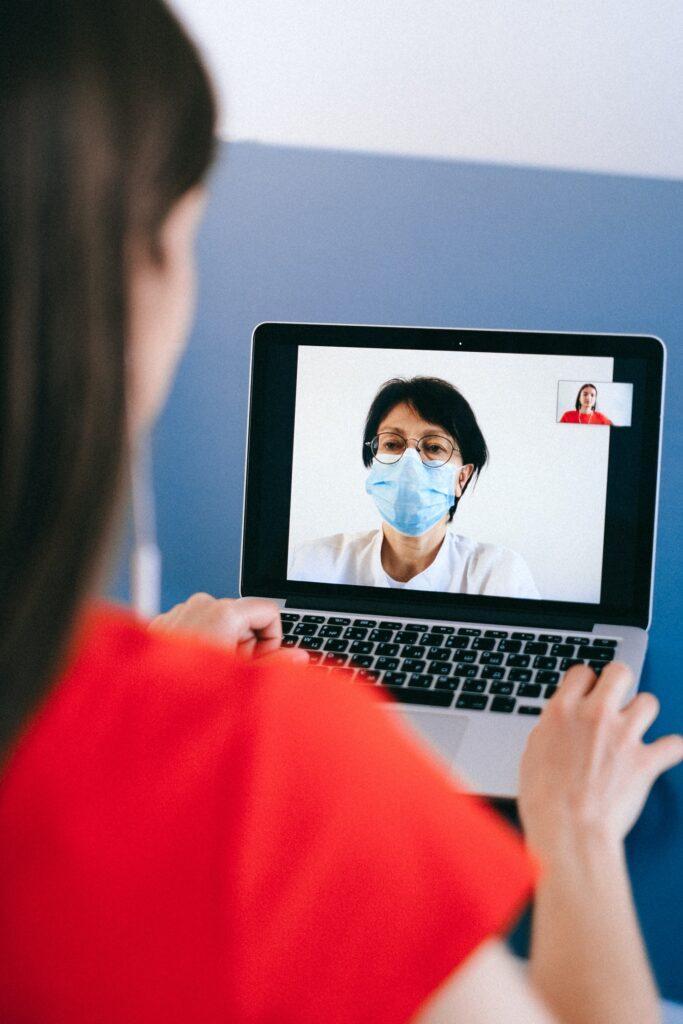Telemedicine has experienced significant growth over the past decade due to rapid technological advancements, profoundly influencing our way of life. Digitalization has immensely improved the healthcare industry. You might have heard about telemedicine by now, given the state of the world. In today’s fast-paced world, technology is incorporated into almost every aspect of our lives. From placing food orders to attending classes, virtual experiences have largely replaced physical ones. The healthcare industry is also undergoing change. Telemedicine, a growing industry that combines technology and medicine, provides quick and effective care.

Table of Contents
Introduction
Telemedicine is a symbol of the convergence of medical knowledge and technological advancement. This dynamic industry has emerged as a result of the ongoing search for more practical and effective healthcare solutions. Telemedicine eliminates geographic barriers and addresses issues with healthcare accessibility by enabling patients to consult with medical professionals from the comfort of their homes. This approach eases the burden on established healthcare infrastructure while streamlining the consultation process. In essence, telemedicine opens the door to a time when receiving medical guidance and treatment is as simple as clicking a button.
What is Telemedicine?
Telemedicine is the practice of providing healthcare treatments to patients without an in-person visit through the use of software and electronic communication. This technology-driven strategy includes a wide range of contemporary IT applications and services, such as remote patient monitoring, live videoconferencing for interactive medicine, the transfer of still images, and e-health websites.
Key Components of Telemedicine
Real-Time Consultations: Face-to-face consultations between doctors and patients are possible with the use of video conferencing solutions. This live engagement may be as straightforward as a routine physical or as intricate as a specialist consultation.
Store-and-Forward (Asynchronous Consultation): Instead of being sent to a medical expert in real-time for evaluation, medical data such as lab reports, pictures, and videos are kept and sent to them at a convenient time.
Remote Patient Monitoring: This enables the monitoring of patients in their own homes through the use of technology that can gather and transfer data to a healthcare professional. For individuals with chronic conditions, blood pressure or glucose levels, for example, can be remotely monitored.
Mobile Health: Devices and apps for mobile use provide services and information related to health. This could be apps that connect you directly to your healthcare practitioner, health tracking tools, or medication reminders.
Benefits of Telemedicine:
Accessibility: Telemedicine is a lifeline for people who live in rural areas or places where there aren’t enough medical professionals. It makes healthcare available to everyone, wherever they may be.
Convenience: Leave the long lines and the drive to the clinic behind. Patients can consult with their doctors through telemedicine from the convenience of their own homes.
Cost-Efficiency: Many telehealth services are less expensive than standard doctor visits. Additionally, people spend less on parking, transportation, and occasionally even prescription drugs when they use online pharmacies.
Safety: Telemedicine reduces unneeded exposure to pathogens in healthcare settings, which is particularly important during epidemics and pandemics.
Specialized Consultations: Patients can communicate with experts from all around the world, overcoming any geographic restrictions on their access to high-quality healthcare.

How Does Telemedicine Work?
From the standpoint of the patient, telemedicine frequently starts with a web portal offered by a healthcare organization or a particular piece of software or app created for telehealth consultations. Having created an account:
A consultation can be scheduled, with the patient selecting the preferred date and time.
The patient logs in and starts a secure video call with the doctor at the appointed time.
The doctor may make diagnoses, offer suggestions, and even issue prescriptions during the session. Some sites even enable the delivery of prescribed medications to the patient’s door.
Telemedicine necessitates the incorporation of a telehealth platform into the daily operations of healthcare professionals. This could entail setting up a quiet, professional area to conduct these online consultations, providing training on the program, and guaranteeing secure and reliable internet connectivity.
Why is Telemedicine Important?
Particularly in underserved or rural locations, telemedicine can significantly narrow the gap between individuals and immediate healthcare treatments. Unexpected events like the COVID-19 pandemic, which highlighted the need for remote healthcare solutions to stop the spread of contagious diseases, have further propelled the global push for telemedicine.
Telemedicine, which essentially combines technology with healthcare, aims to revolutionize how we approach medical consultations and treatments. Telemedicine will surely be a crucial tool as we navigate the digital age to make sure that top-notch healthcare is only a click away.
Challenges and Considerations:
While telemedicine is transforming healthcare, it’s not without its challenges.
Technical Barriers: Not everyone has access to high-speed internet or understands how to use digital platforms.
Licensing and Regulations: Healthcare professionals often need to be licensed in the patient’s state or country to provide telemedicine services, which can be a bureaucratic challenge.
Data Security: Protecting patient data is paramount, and telehealth platforms need robust security measures to prevent breaches.
Human Touch: Many patients and practitioners value the interpersonal connection that comes with in-person visits.
What is the difference between telehealth and telemedicine?
Telehealth vs. Telemedicine: Understanding the Distinctions
In discussions about digital healthcare, two terms that frequently emerge are “telehealth” and “telemedicine.” While they’re often used interchangeably, there are subtle distinctions between them. As we move towards an increasingly connected healthcare system, understanding these differences becomes crucial for both practitioners and patients.
Telemedicine:
Definition: Telemedicine specifically refers to remote clinical services provided by healthcare professionals to patients via technology. This means it’s an aspect of digital health that directly involves medical care.
Key Features:
Remote Clinical Services: This encompasses diagnosis, treatment, and consultations done remotely via video conferencing, phone calls, or other digital communication methods.
Specialized Consultations: Patients can connect with specialists who might be far away, breaking geographical constraints.
Digital Prescriptions: After a telemedicine consultation, patients frequently receive digital prescriptions that can be filled at nearby or online pharmacies.
Example: A video consultation with a dermatologist about a skin condition, a psychiatrist providing therapy over a call, or a primary care physician assessing flu symptoms via video chat.

Telehealth:
Definition: Telehealth has a broader scope and encompasses all aspects of healthcare facilitated by technology, not just clinical services. This includes non-clinical services like education, administration, and training.
Key Features:
Comprehensive Care: Beyond clinical services, telehealth also includes preventive, promotive, and curative aspects of health.
Education and Training: This might involve training for healthcare professionals, patient education, or public health broadcasts.
Healthcare Management: This includes administrative meetings, continuous medical education, and other non-direct care activities that are facilitated remotely.
Example: A diabetic patient attending a webinar on dietary management, a nurse taking an online course on wound care, or administrative personnel attending a virtual meeting on hospital management.
In a Nutshell:
While both telehealth and telemedicine leverage technology to enhance healthcare services, the primary distinction lies in their scope. Telemedicine is a subset of telehealth, focusing exclusively on the clinical aspect of remote healthcare. In contrast, telehealth covers a broader range of remote health-related activities, including both clinical and non-clinical services.
With the continuous evolution of digital healthcare platforms and growing acceptance from both providers and patients, both telehealth and telemedicine are set to play pivotal roles in shaping the future of global healthcare.
How does telemedicine reduce costs?
Reduced Travel Expenses: For consultations, patients no longer need to travel to clinics or hospitals. Due to this, transportation expenses such as fuel, fares for public transportation, and parking fees are reduced.
Fewer Missed Appointments: The ease of remote consultations reduces the possibility of patients skipping appointments. Missed appointments frequently result in unused time slots that may have been used for other patients, potentially costing the practitioner money.
Decreased Hospital Readmissions: Better post-operative or post-treatment monitoring is made possible through telemedicine. This proactive strategy can identify problems before they become costly readmissions, preventing complications.
Lower Overhead for Practitioners: There is less need for real offices, utilities, and on-site staff when consultations are conducted virtually. The healthcare industry may experience huge financial savings as a result.
Effective Resource Allocation: Hospitals and clinics can move resources from less important to more important areas, resulting in improved utilization and less waste.
Reduced Urgent Care and ER Visits: Patients can swiftly address health concerns with 24/7 access to healthcare consultations, avoiding costly urgent care or ER visits for non-emergencies.
Reduced Patient No-shows: Higher commitment rates may result from more convenient scheduling and remote consultations, which would reduce the financial impact of patient no-shows.
Streamlined Administrative Tasks: Billing, scheduling, and patient record-keeping chores may all be streamlined and automated with the help of telemedicine platforms, saving time and money on administrative overhead.
Early Diagnosis and Treatment: Timely interventions made possible by telemedicine can enable early diagnosis and treatment, which frequently results in shorter and less expensive treatment regimens.
Broader Specialist Access: Primary care providers can work with experts remotely rather than referring a patient to a far-off specialist, which could include travel and lodging fees.
Reduced Ancillary Costs: Aside from travel fees, in-person meetings frequently require childcare services or time off work. For many patients, telemedicine can reduce or even eliminate these associated expenditures.
Group Consultations: By enabling group sessions, some telemedicine systems help professionals better utilize their time and resources by educating or treating numerous patients at once.
In conclusion, even though the initial cost of telemedicine equipment may seem high, both consumers and healthcare professionals will ultimately save a lot of money. Patients enjoy prompt, convenient care, while providers are able to work more productively and affordably. Telemedicine will play a crucial role in making healthcare more sustainable and inexpensive as technology develops and its use rises.
The Road Ahead:
The development of telemedicine represents a fundamental change in the future delivery of healthcare services, not just a passing fad. By providing individualized treatment plans, proactive diagnoses, and other benefits, the integration of artificial intelligence and machine learning can improve these services even more.
But it’s crucial to realize that telemedicine is an addition to conventional medicine rather than its substitute. There will always be situations where an in-person visit is indispensable, despite the fact that it has many benefits.
In conclusion, telemedicine will become increasingly important in improving the accessibility, practicality, and effectiveness of healthcare as technology develops and permeates more and more aspects of our daily lives. The secret to a healthy future for everyone will, as with all technical improvements, be a balanced approach, tackling the obstacles and embracing the potential.
“Thank you for reading this blog post! For more insightful articles, please visit https://foodhealthandrelax.com/. For further reference on related topics, you can also check out Wikipedia’s article on telemedicine. We appreciate your support and look forward to providing more valuable content.

